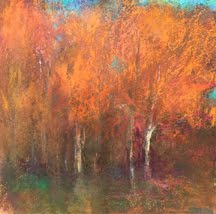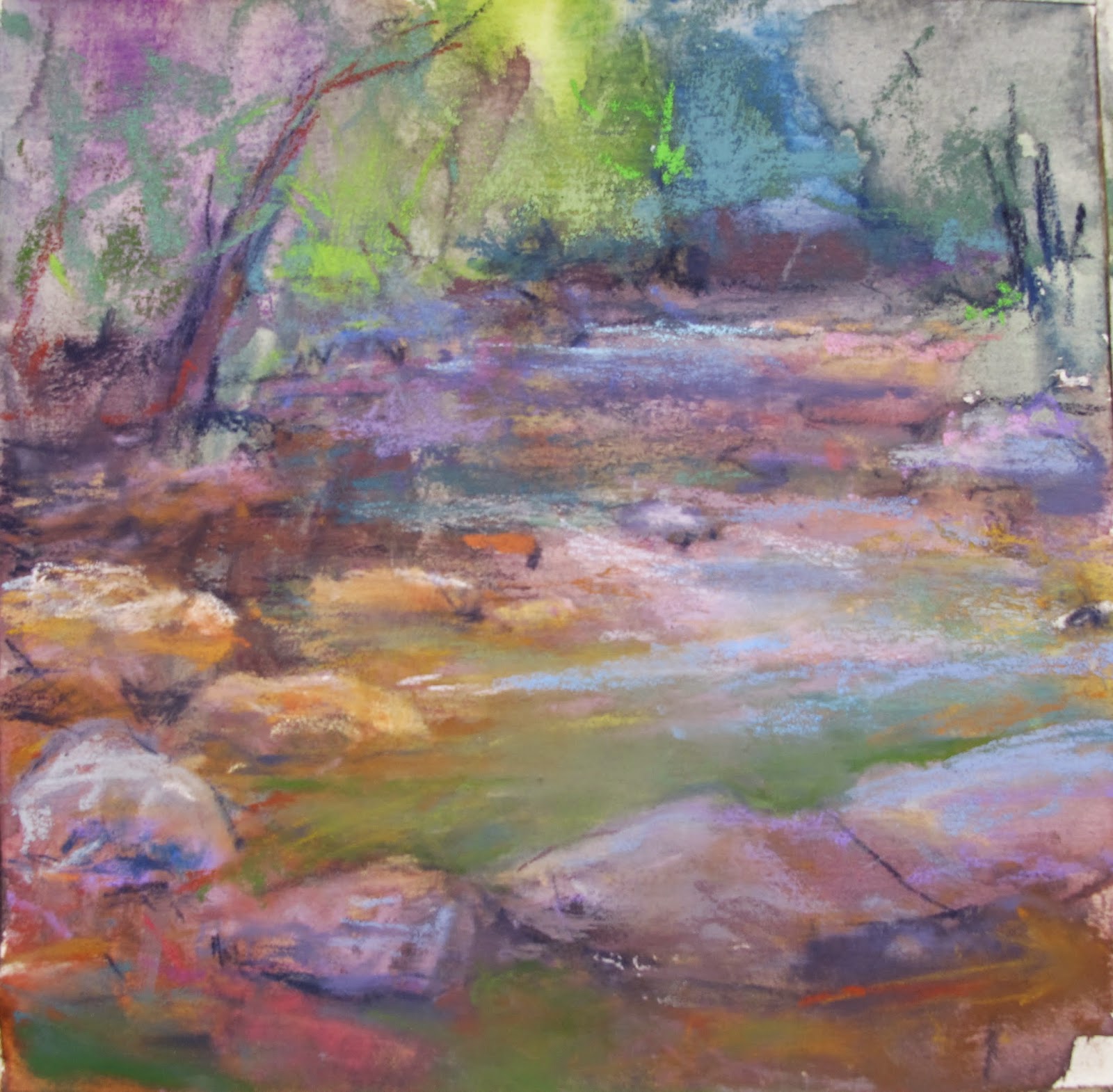Monday, June 30, 2014
Wednesday, June 25, 2014
poison ivy island: study to large
Monday, June 23, 2014
river love continues
River love ... painted on different surfaces. The top one is Rives BFK and the bottom is Uart 400. Lots of exciting things happening in the studio as well. more about those later.
Saturday, June 21, 2014
great time for a summer road trip to DC
Ahhh, summertime. It is the perfect time for a road trip. So how about DC as your destination? So much is happening, the major crowds are long gone and it's all free(your tax dollars at work). Here is a list of some of my faves.
1. Kiyochika, Master of the Night- Freer/Sackler Gallery, Smithsonian- free
The gallery displays master printmaker, Kobayashi Kiyochika beautiful woodblocks. Dawn, dusk and night are the focus of his woodblock prints.
2. An American in London, Whistler and the Thames, Freer /Sackler Gallery, Smithsonian -free What could be better than Whistler's amazing, nearly abstract, nocturnes of the river Thames? Maybe adding on his prints and sketches and watercolors that give you a view inside his thinking. Included also are some of the Japanese prints that influenced him. Wow!
3. Life keeps getting better with a exhibition of Degas and Cassatt, National Gallery of Art - Smithsonian, free! This exhibition demonstrates the affinity between both artists. A perfect friendship Degas and Cassatt, engaged in intense dialogues, challenged each other and shared their many experiments with new techniques. The show includes sketches, paintings and prints.
4. Andrew Wyeth: Looking out, Looking in, National Gallery of Art- Smithsonian- free! Spare and elegant, these paintings are free of the narrative element associated with the artist’s better-known figural compositions. The abstract qualities of his work are therefore more readily apparent, and Wyeth emerges as an artist deeply concerned with the visual complexities posed by the transparency, symbolism, and geometric structure of windows.
5. And last in between exhibitions be sure to visit the Smithsonian's Folklife Festival- June 25-July 6. It's free as well and right on the mall smack between the Freer and the NGA. Art, performances, hands-on demonstrations and great ethnic food.
1. Kiyochika, Master of the Night- Freer/Sackler Gallery, Smithsonian- free
The gallery displays master printmaker, Kobayashi Kiyochika beautiful woodblocks. Dawn, dusk and night are the focus of his woodblock prints.
3. Life keeps getting better with a exhibition of Degas and Cassatt, National Gallery of Art - Smithsonian, free! This exhibition demonstrates the affinity between both artists. A perfect friendship Degas and Cassatt, engaged in intense dialogues, challenged each other and shared their many experiments with new techniques. The show includes sketches, paintings and prints.
4. Andrew Wyeth: Looking out, Looking in, National Gallery of Art- Smithsonian- free! Spare and elegant, these paintings are free of the narrative element associated with the artist’s better-known figural compositions. The abstract qualities of his work are therefore more readily apparent, and Wyeth emerges as an artist deeply concerned with the visual complexities posed by the transparency, symbolism, and geometric structure of windows.
5. And last in between exhibitions be sure to visit the Smithsonian's Folklife Festival- June 25-July 6. It's free as well and right on the mall smack between the Freer and the NGA. Art, performances, hands-on demonstrations and great ethnic food.
Wednesday, June 18, 2014
poison ivy island
Trouble is, my work is normally not place specific. Instead it's more about the feeling and the vibration of colors makes the feeling. So here I have my first satisfactory study of "poison ivy island." It's a pastel, about 9"x12". Wish me luck!
Sunday, June 15, 2014
later afternoon glow, distilled
Trying to find ways to create the late afternoon glow from the marshlands at Chincoteague. I want a distilled landscape, without fluff and details.
using marks and smooth
This river series is my true love. Therefore at 5:30 in the morning I was walking down the path just to see her. A beaver greeted me, they were waiting.
My idea this time was to see the layers. Make it more about the surface. The watercolor below with thin layers of pastel is topped by marks of pastel.
My idea this time was to see the layers. Make it more about the surface. The watercolor below with thin layers of pastel is topped by marks of pastel.
Friday, June 13, 2014
working in a series
Working in a series is one of the most important tools we artists have to nourish growth. Most times artists build series around a theme: river paintings, window paintings, still life with waxed paper, or cityscapes, just to name a few. Sometimes it's around a format, like all squares. The one thing that binds these ideas is that each painting in a series builds on the next painting. The process takes the artist down a path of discovery.
Series can just shout out to us, others whisper, some you have to find. My river series has been ongoing for many years. I love that river and have still not exhausted its possibilities.
Here are four ways to find your next series.
1. Line up your ten favorite paintings. Analyze them. What did you do in those ten that was so successful. Write it down and be ready to build on those ideas.
2. Choose a new format and stick to it. Do you want a more peaceful painting? Choose an elongated rectangle. Look at the Japanese woodcuts. Try diptych or more.
3. Find a new surface. If you normally work with a sanded paper try making your own surface. If you paint on smooth canvas try wood with a vibrant surface pattern. Take yourself out of your comfort zone.
4. Make an exploration of color. Limit your palette to certain color harmonies.Make many small studies (3x4) before moving into bigger work. take yourself out of your color rut.
When you have a series begun make certain to keep all of them out to view each day. Number them on the back. Look and grow with the previous work.
One of the most exciting and inspirational series I have seen is Marla Baggetta's Variations. Here is a link to the book she made about it. Wow!
The most important thing about a series is the fact that it drives you and you can't wait to get back to it.
Monday, June 9, 2014
moving water and student show
Moving water is always a huge challenge. It's always changing and it has reflections from the land and bouncy mirror-like parts on the white water. To me it helps to divide it into warm and cool: what is in shadow and what is in sun?
The rocks are a perfect resting point from the greens. The oranges and violets make it sing better.
BTW Three of my most talented young students had their first show at my studio yesterday. They have been working for 3 years and their dedication is obvious in their work quality. For this show they not only created the work but they learned how to frame it and wrote their first artist's statement.
Thursday, June 5, 2014
tricky greens
Recently when my teenage class was outdoors painting the common cry was, "There are too many greens!" Or, "Greens are boring, what do I do?" Greens are incredibly tricky. In order to make a painting full of warm and cool greens to work you have to search for the other secondary colors that will complement green. That brings us to violet and orange. The famous Richard McKinley says, "The secret to green is orange and violet is its friend." So when looking at those endless greens out there now, think...where can I see violet? How can pieces of orange in my greens and around enhance the green?
Sunday, June 1, 2014
more buttercups, revisit
This one is pastel on a gesso and marble dust board. It also has a thick watercolor underpainting. I am going through older paintings that need resolve.
Subscribe to:
Posts (Atom)



















